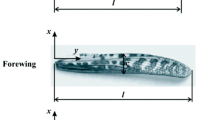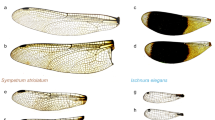Summary
The functional mechanics of the forewingtwisting ofLocusta migratoria L. is described and demonstrated by means of plastic models. The upstroke-supination (“Z-profile”) is produced by elastic and aerodynamic forces only. A tonic muscle, the muscle of the axillary 3, acts as upstroke-pronator, flattening the Z-profile. The three direct wing depressor muscles (basalar muscles, subalar muscle) pronate the wing during the downstroke. The basalar muscles initiate the wing-turning at the begin of downstroke by clicking the Z-profile into a reverse clap profile. The muscle of the axillary 3 decreases the downstroke-pronation, acting in this phase as a supinator. This muscle is therefore able to increase the aerodynamical angle of attack in both wingstroke phases. The functional significance of the muscles for the control of flight is discussed.
Similar content being viewed by others
Literatur
Jensen M (1956) Biology and physics of locust flight. III. The aerodynamics of locust flight. Philos Trans R Soc Lond [Biol] 239:511–552
Möhl B, Zarnack W (1977) Activity of the direct downstroke flight muscles ofLocusta migratoria (L.) during steering behaviour in flight. II. Dynamics of the time shift and changes in the burst length. J Comp Physiol 118:235–247
Nachtigall W (1967) Getrennte Systeme im Fliegenthorax für die Erzeugung und Verteilung aerodynamischer Kräfte. Naturwissenschaften 54:323
Nachtigall W (1981) Der Vorderflügel großer Heuschrecken als Luftkrafterzeuger. I. Modellmessungen zur aerodynamischen Wirkung unterschiedlicher Flügelprofile. J Comp Physiol 142:127–134
Nachtigall W, Wilson DM (1967) Neuro-muscular control of dipteran flight. J Exp Biol 47:77–97
Pfau HK (1976) Ein Muskel zur Feineinstellung des Vorderflügelanstellwinkels beiLocusta migratoria L. Verh Dtsch Zool Ges 1976:246
Pfau HK (1977a) Zur Morphologie und Funktion des Vorderflügels und Vorderflügelgelenks vonLocusta migratoria L. Fortschr Zool 24:341–345
Pfau HK (1977b) Funktion einiger direkter, tonischer Flügelmuskeln vonCalliphora erythrocephala Meig. Verh Dtsch Zool Ges 1977:275
Pfau HK (1978a) Funktionsanatomische Aspekte des Insektenflugs. Zool Jahrb Abt Anat Ontog Tiere 99:99–108
Pfau HK (1978b) Bedeutung des Vorderflügel-Streckrezeptors und -Chordotonalorgans für die Registrierung der geometrischen Flügelanstellung beiLocusta migratoria L. Verh Dtsch Zool Ges 1978:247
Pfau HK, Honomichl K (1979) Die campaniforraen Sensillen des Flügels vonCetonia aurata L. undGeotrupes silvaticus Panz. (Insecta, Coleoptera) in ihrer Beziehung zur Flügelmechanik und Flugfunktion. Zool Jahrb Abt Anat Ontog Tiere 102:583–613
Snodgrass RE (1929) The thoracic mechanism of a grasshopper, and its antecedents. Smithson Misc Collect 82(2): 1–111
Snodgrass RE (1935) Principles of insect morphology. McGraw-Hill, New York London
Weber H (1933) Lehrbuch der Entomologie. Fischer, Jena
Weis-Fogh T (1956) Biology and physics of locust flight. IV. Notes on sensory mechanisms in locust flight. Philos Trans R Soc Lond [Biol] 239:553–584
Wilson DM, Weis-Fogh T (1962) Patterned activity of co-ordinated motor-units, studied in flying locusts. J Exp Biol 39:643–667
Zarnack W, Möhl B (1977) Activity of the direct downstroke flight muscles ofLocusta migratoria (L.) during steering behaviour in flight. I. Patterns of time shift. J Comp Physiol 118:215–233
Author information
Authors and Affiliations
Rights and permissions
About this article
Cite this article
Pfau, H.K., Nachtigall, W. Der Vorderflügel großer Heuschrecken als Luftkrafterzeuger. J. Comp. Physiol. 142, 135–140 (1981). https://doi.org/10.1007/BF00605485
Accepted:
Issue Date:
DOI: https://doi.org/10.1007/BF00605485




